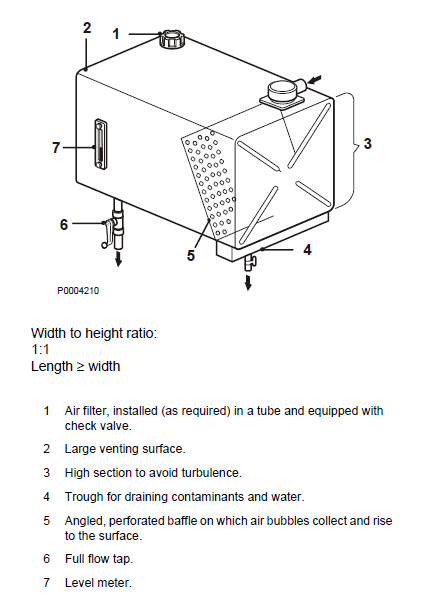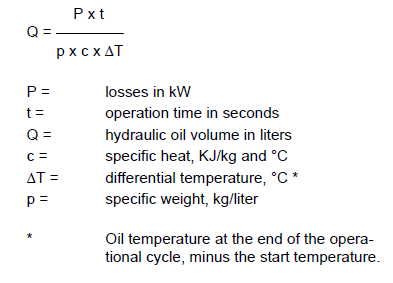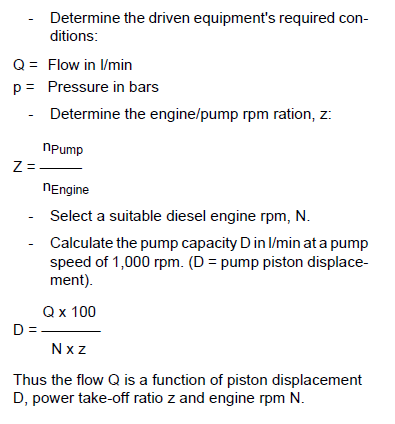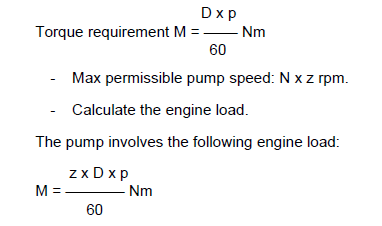Compressed Air Filter
All compressors supplied by Volvo Penta must be equipped with air filtration before the air inlet. Air filters are included in the compressor kit and can also be ordered separately. The compressor air filter must be changed at the same time as the engine air filter. The compressor inlet must be connected to the combustion air duct between the engine air filter and the turbocharger (if possible vertically from above). The connection point must always be positioned before the crank case ventilation connection to avoid the compressor drawing in oil. On the other hand, the distance to the turbocharger must be sufficient to prevent the pulsating compressor from affecting the turbocharger. The air inlet hose must have an inner diameter of at least 22 mm (0.87") and be suitable for hydraulic oil. When engine coolant is drained, the compressor cooling system must also be drained if there is a risk of freezing.
Hydraulic Systems
General
Volvo Penta supplies different types of hydraulic pumps. These pumps are only intended for power steering systems and are not designed for continuous use. However, Volvo Penta is able to supply a number of different flanges for engine-mounted hydraulic pumps for continuous operations. Refer to the Volvo Penta Sales Support Tool, Partner Network.
IMPORTANT!
Because hydraulic pumps involve large cyclical torque variations to the camshaft gear it is essential that pumps not supplied by Volvo Penta be approved by Volvo Penta before installation on the engine concerned.
Hydraulic Steering Pumps delivered by Volvo Penta
The pump gear is installed on a cylindrical shaft with a key. Before the gear is installed on the shaft it must be heated to maximum 200 °C (392 °F).
D9 and D16 engines
For TAD94X and TAD164X engines it is possible to order a hydraulic steering pump on which the fuel pump is end mounted on the power steering pump. There is a safety valve in the hydraulic pump, but the supplier nevertheless recommends that a flow and pressure valve be installed in the circuit. If there is no requirement for a hydraulic steering servo pump, a dummy is installed instead of the pump (in the same housing as the fuel pump. Refer to the Volvo Penta Sales Support Tool, Partner Network for technical details.
System Configuration
In order for the hydraulic pump to function satisfactorily it must be installed correctly. The following factors influence function:
• Tank
• Suction line
• Inlet line
• Drain line
• Oil filter
• Air filter
• Hydraulic oil

Tank
In order for the hydraulic tank to function correctly a number of simple calculations need to be made. For satisfactory hydraulic function, consideration must be given when designing the tank to system venting, oil heat absorption and expansion. The collection of water and dirt is another important function. The illustration shows an optimal tank. Maximum hydraulic oil volume in the hydraulic tank must be 10 - 20 % lower than tank volume. Hydraulic oil volume ≥ Pump flow.
Heat absorption
Transmission losses occur in all hydraulic systems, as do hydraulic pump and engine losses. All of these are transformed into heat in the oil, which means a choice between cooling the oil or allowing it to absorb heat. If operational time exceeds one hour the oil will usually require cooling.
The required tank volume can be calculated according to the following:

NOTICE! Cooling capacity is not doubled if tank volume is doubled. Conversely, heat absorption capacity is doubled. Cooling capacity only increases by 50 %. Remember to adjust the size of lines, tank and filters to the systems maximum circulation flow.
Suction line
Oil flow to pump suction must be free and without restrictions. This requires a suction line of sufficient diameter and the shortest possible length without flow limitations. Recommended flow speed: 0.5 - 1 m/s (1.6 - 3.3 ft./s).
Inlet line
Too narrow an inlet line causes unnecessary pressure losses that are transformed into heat. At a flow of 100 l/min a pressure drop of 10 bar (145 PSI) will create around 1.7 kW of heat. A flow speed of 4 to 7 m/s (13.1 - 23.0 ft./s) is recommended at a pressure
of 100-300 bar (1,450 - 4,350 PSI).
Drain line
Pumps that are not self draining must have a drain line installed directly on the tank. The flow to the drain will increase with pump load. Overpressure will occur in the pump when the oil in the drain line accelerates and flow increases. This pressure must not exceed 2 bar (29 PSI) in normal conditions. A drain line the same size as the pump connection is recommended.
Oil and air filter
Nominal filter flow speed must correspond to the maximum flow that can occur in the system. For example, a system with a double-acting ram, such as a crane, can give double the pump flow in return. The following filtering speeds are recommended for maximum pump lifetime:
Clean environment or low pressure 25 μm
Dirty environment or high pressure 10 μm
Hydraulic oil
A suitable hydraulic oil grade must be used. At operational temperature oil viscosity must be 20 to 30 cSt.
General Recommendations
A high power take-off ratio (greater than 1:1) means that a smaller pump can be used. This is usually the best alternative both technically and economically. An exception is when a diesel engine must be run at high rpm, as a lower power take-off ratio is necessary to avoid overspeeding the pump.

Check
- Compare the power take-off max permissible load with the pump max permissible load.

Note that the formulae do not take frictional losses (mechanical efficiency) into account. However, the discrepancy is not greater than around 2 %.
- Use the engine power graphs and hydraulic pump data to make sure the engine is able to
drive the pump.
The following formula can be used to calculate hydraulic pump power requirement:

Note that efficiency (η) varies depending on pump type and size and operational conditions.
Typical efficiency is 85 to 95 % It is important to note that a hydraulic pump with 90 % efficiency emits twice the heat as a pump with 95 % efficiency.
For More Volvo Engine workshop information, please visit:
Volvo Penta Diesel Engine Alignment
Description and Function of the System Components
Copyright © Guangxi Dingbo Generator Set Manufacturing Co., Ltd. All Rights Reserved | Sitemap
Update cookies preferences